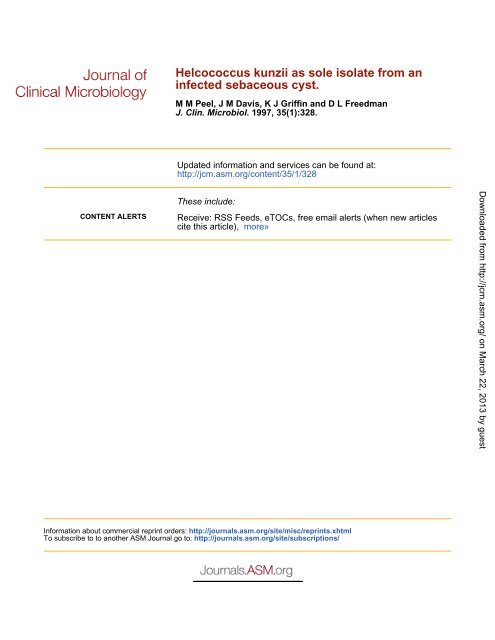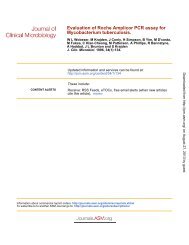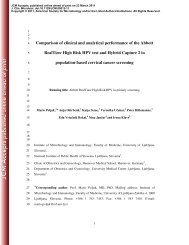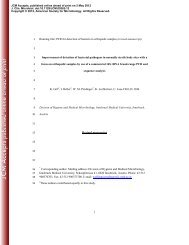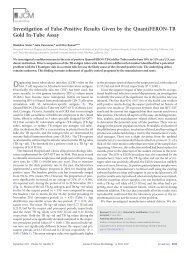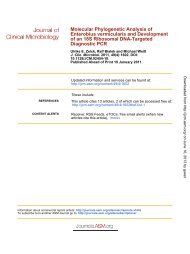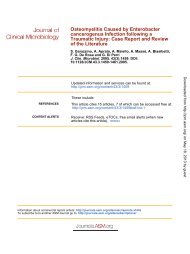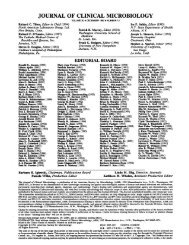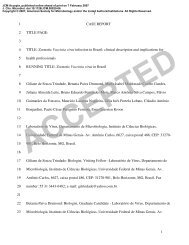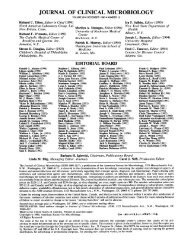Helcococcus kunzii as Sole Isolate from an Infected Sebaceous Cyst
Helcococcus kunzii as Sole Isolate from an Infected Sebaceous Cyst
Helcococcus kunzii as Sole Isolate from an Infected Sebaceous Cyst
Create successful ePaper yourself
Turn your PDF publications into a flip-book with our unique Google optimized e-Paper software.
CONTENT ALERTS<br />
<strong>Helcococcus</strong> <strong>kunzii</strong> <strong>as</strong> sole isolate <strong>from</strong> <strong>an</strong><br />
infected sebaceous cyst.<br />
M M Peel, J M Davis, K J Griffin <strong>an</strong>d D L Freedm<strong>an</strong><br />
J. Clin. Microbiol. 1997, 35(1):328.<br />
Updated information <strong>an</strong>d services c<strong>an</strong> be found at:<br />
http://jcm.<strong>as</strong>m.org/content/35/1/328<br />
These include:<br />
Receive: RSS Feeds, eTOCs, free email alerts (when new articles<br />
cite this article), more»<br />
Information about commercial reprint orders: http://journals.<strong>as</strong>m.org/site/misc/reprints.xhtml<br />
To subscribe to to <strong>an</strong>other ASM Journal go to: http://journals.<strong>as</strong>m.org/site/subscriptions/<br />
Downloaded <strong>from</strong><br />
http://jcm.<strong>as</strong>m.org/<br />
on March 22, 2013 by guest
JOURNAL OF CLINICAL MICROBIOLOGY, J<strong>an</strong>. 1997, p. 328–329 Vol. 35, No. 1<br />
0095-1137/97/$04.000<br />
Copyright 1997, Americ<strong>an</strong> Society for Microbiology<br />
<strong>Helcococcus</strong> <strong>kunzii</strong> <strong>as</strong> <strong>Sole</strong> <strong>Isolate</strong> <strong>from</strong> <strong>an</strong> <strong>Infected</strong><br />
<strong>Sebaceous</strong> <strong>Cyst</strong><br />
MARGARET M. PEEL, 1 * JENNIFER M. DAVIS, 1 KEVIN J. GRIFFIN, 2 AND DAVID L. FREEDMAN 3<br />
Microbiological Diagnostic Unit, Department of Microbiology, The University of Melbourne, Parkville, 1 <strong>an</strong>d Department<br />
of Pathology 2 <strong>an</strong>d Department of Surgery, 3 Sw<strong>an</strong> Hill District Hospital, Sw<strong>an</strong> Hill, Victoria, Australia<br />
Received 14 June 1996/Returned for modification 28 August 1996/Accepted 8 October 1996<br />
<strong>Helcococcus</strong> <strong>kunzii</strong> w<strong>as</strong> isolated in pure culture <strong>from</strong> pus drained <strong>from</strong> <strong>an</strong> infected sebaceous cyst <strong>as</strong>sociated<br />
with marked cellulitis. The cyst w<strong>as</strong> excised one month later after the inflammation had subsided with<br />
flucloxacillin treatment. This is the first report of the isolation of H. <strong>kunzii</strong> <strong>as</strong> the sole pathogen <strong>from</strong> <strong>an</strong><br />
infected site.<br />
<strong>Helcococcus</strong> <strong>kunzii</strong> w<strong>as</strong> first described in 1993 <strong>as</strong> a new genus<br />
<strong>an</strong>d species of catal<strong>as</strong>e-negative, facultatively <strong>an</strong>aerobic, grampositive<br />
cocci (2). H. <strong>kunzii</strong> shares m<strong>an</strong>y phenotypic characteristics<br />
with Aerococcus virid<strong>an</strong>s but differs in its growth rate <strong>an</strong>d<br />
requirements <strong>an</strong>d colonial morphology. H. <strong>kunzii</strong> produces<br />
pinpoint, nonhemolytic or slightly -hemolytic colonies on<br />
sheep blood agar after incubation for 24 h (1). The amount of<br />
growth <strong>an</strong>d size of colonies are the same on blood agar plates<br />
incubated aerobically, in 5% CO 2, or <strong>an</strong>aerobically. In contr<strong>as</strong>t,<br />
A. virid<strong>an</strong>s grows poorly or not at all under <strong>an</strong>aerobic<br />
conditions <strong>an</strong>d gives strong -hemolysis around colonies of 0.5<br />
to 1 mm in diameter on blood agar plates incubated aerobically<br />
for 24 h (2, 3). Apart <strong>from</strong> the phenotypic differences between<br />
these two taxa, comparison of the GC content of their DNA<br />
<strong>an</strong>d comparative <strong>an</strong>alysis of their 16S rRNA sequence data<br />
indicate that they are phylogenetically different <strong>an</strong>d distinct<br />
(2).<br />
We record the isolation of H. <strong>kunzii</strong> in pure culture <strong>an</strong>d<br />
heavy growth <strong>from</strong> pus <strong>from</strong> <strong>an</strong> infected sebaceous cyst. This is<br />
the first report of the isolation of H. <strong>kunzii</strong> in pure culture <strong>from</strong><br />
<strong>an</strong> infected site, <strong>an</strong>d it indicates that this newly described<br />
bacterium is capable of acting <strong>as</strong> the sole pathogen.<br />
C<strong>as</strong>e report. A 36-year-old m<strong>an</strong> w<strong>as</strong> admitted to the hospital<br />
with <strong>an</strong> infected sebaceous cyst on his right shoulder. Although<br />
the cyst had been present for 2 years, it first showed signs of<br />
inflammation 2 weeks before his admission. He had a history of<br />
hypertension, obesity, <strong>an</strong>d hypercholesteremia. The cyst me<strong>as</strong>ured<br />
3 by 4 cm in size <strong>an</strong>d w<strong>as</strong> <strong>as</strong>sociated with a marked<br />
cellulitis. It w<strong>as</strong> incised <strong>an</strong>d drained, <strong>an</strong>d a swab of the pus w<strong>as</strong><br />
submitted for microbiological examination. Culture of the pus<br />
yielded a gram-positive coccus, which w<strong>as</strong> later identified <strong>as</strong> H.<br />
<strong>kunzii</strong>.<br />
Therapy with flucloxacillin w<strong>as</strong> instituted pending identification<br />
of the infective agent. The initial treatment schedule<br />
consisted of four 1-g doses given intravenously at 8-h intervals.<br />
The patient w<strong>as</strong> then discharged on a regimen of 0.5 g of<br />
flucloxacillin orally every 8 h for 5 days. The inflammation<br />
subsided, <strong>an</strong>d the cyst w<strong>as</strong> excised 1 month later. Histopathologic<br />
examination of the cyst showed <strong>an</strong> epidermal cyst with<br />
chronic inflammation.<br />
* Corresponding author. Mailing address: Microbiological Diagnostic<br />
Unit, Department of Microbiology, The University of Melbourne,<br />
Parkville, Victoria, 3052, Australia. Phone: 61 3 9344 7736. Fax: 61 3<br />
9344 7833.<br />
328<br />
Microbiology. Examination of a gram-stained smear of the<br />
pus showed moderate numbers of polymorphonuclear cells<br />
<strong>an</strong>d of gram-positive cocci. Culture of the pus on horse blood<br />
agar incubated aerobically <strong>an</strong>d <strong>an</strong>aerobically at 35C <strong>an</strong>d on<br />
chocolate agar incubated in a 7.5% CO 2-enriched atmosphere<br />
yielded pinpoint colonies after 16 h, <strong>an</strong>d small, grayish colonies<br />
with slight -hemolysis after a further 24 h. An initial attempt<br />
at identification by the rapid ID 32 Strep identification system<br />
(bioMérieux, Marcy-l’Etoile, Fr<strong>an</strong>ce) w<strong>as</strong> unsuccessful, <strong>an</strong>d<br />
the isolate w<strong>as</strong> referred to the Microbiological Diagnostic Unit<br />
for identification.<br />
At the reference laboratory, the isolate grew slowly on horse<br />
blood agar, producing pinpoint, grayish, nonhemolytic colonies<br />
after 24 h of incubation at 35C, which showed slight -hemolysis<br />
after 48 h. Equivalent growth w<strong>as</strong> obtained on horse blood<br />
agar plates incubated aerobically, <strong>an</strong>aerobically, <strong>an</strong>d in a 5%<br />
CO 2-enriched atmosphere. The isolate did not grow on Mac-<br />
Conkey agar or at 45C, <strong>an</strong>d it required the addition of 5%<br />
serum to all b<strong>as</strong>al media for satisfactory growth.<br />
A gram-stained smear of the culture showed gram-positive<br />
cocci arr<strong>an</strong>ged mainly in pairs <strong>an</strong>d clusters with some tetrads.<br />
The cocci were nonmotile, catal<strong>as</strong>e negative, <strong>an</strong>d susceptible to<br />
a 30-g v<strong>an</strong>comycin disk (3). The enzyme profile <strong>an</strong>d biochemical<br />
characteristics of the isolate were determined by the API<br />
20 Strep identification system (bioMérieux) <strong>an</strong>d in conventional<br />
test media enriched by the addition of 5% inactivated<br />
newborn calf serum. Acid production <strong>from</strong> carbohydrates w<strong>as</strong><br />
tested in a serum-enriched 1% peptone b<strong>as</strong>e with 0.5% NaCl<br />
<strong>an</strong>d bromcresol purple indicator.<br />
The API 20 Strep numerical profile for the isolate w<strong>as</strong><br />
4100413, which is identical to that previously reported for H.<br />
<strong>kunzii</strong> (2). This me<strong>an</strong>s that the isolate gave positive reactions in<br />
this system for esculin hydrolysis, pyrrolidonylarylamid<strong>as</strong>e activity,<br />
<strong>an</strong>d acid production <strong>from</strong> lactose, trehalose, starch, <strong>an</strong>d<br />
glycogen. It gave negative reactions for acetoin production,<br />
hippurate hydrolysis, <strong>an</strong>d the enzymes -galactosid<strong>as</strong>e, -glucuronid<strong>as</strong>e,<br />
-galactosid<strong>as</strong>e, alkaline phosphat<strong>as</strong>e, leucine<br />
aminopeptid<strong>as</strong>e, <strong>an</strong>d arginine dihydrol<strong>as</strong>e, <strong>an</strong>d it did not produce<br />
acid <strong>from</strong> ribose, arabinose, m<strong>an</strong>nitol, sorbitol, inulin,<br />
<strong>an</strong>d raffinose. The results of testing in serum-supplemented<br />
conventional test media were the same for tests that repeated<br />
those of the API 20 Strep system. In addition, the isolate gave<br />
negative reactions on serum-enriched conventional media for<br />
gelatin liquefaction, nitrate reduction, <strong>an</strong>d ure<strong>as</strong>e activity. It<br />
grew in the presence of 6.5% NaCl, <strong>an</strong>d it produced pyrazinamid<strong>as</strong>e<br />
<strong>an</strong>d acid <strong>from</strong> cellobiose, glucose, <strong>an</strong>d maltose but not<br />
Downloaded <strong>from</strong><br />
http://jcm.<strong>as</strong>m.org/<br />
on March 22, 2013 by guest
VOL. 35, 1997 NOTES 329<br />
<strong>from</strong> sucrose. No g<strong>as</strong> w<strong>as</strong> produced <strong>from</strong> glucose in MRS (de<br />
M<strong>an</strong>, Rogosa, Sharpe) broth. The morphological <strong>an</strong>d biochemical<br />
characteristics indicate that the isolate is H. <strong>kunzii</strong> (1–3).<br />
Antimicrobial susceptibility testing, <strong>as</strong> determined by the<br />
E-test method (1), showed that the isolate w<strong>as</strong> susceptible to<br />
penicillin (MIC, 0.094 g/ml), v<strong>an</strong>comycin (MIC, 0.75 g/<br />
ml), <strong>an</strong>d flucloxacillin (MIC, 0.5 g/ml).<br />
Discussion. All 10 patients <strong>from</strong> whom the isolation of H.<br />
<strong>kunzii</strong> h<strong>as</strong> been reported (1) have yielded this bacterium in<br />
mixed cultures that included such bacteria <strong>as</strong> Staphylococcus<br />
aureus <strong>an</strong>d <strong>an</strong>aerobes. However, the only other bacterium isolated<br />
<strong>from</strong> two patients with cellulitis w<strong>as</strong> a coagul<strong>as</strong>e-negative<br />
Staphylococcus sp., which w<strong>as</strong> considered unlikely to have contributed<br />
to the cellulitis. Nonetheless, isolation in mixed culture<br />
makes it difficult to <strong>as</strong>sign a clear-cut pathogenic or potentially<br />
pathogenic role to this new genus.<br />
Seven of the 10 patients were in <strong>an</strong> older age group (57<br />
years of age). In seven of the c<strong>as</strong>es, the site of isolation w<strong>as</strong> the<br />
lower extremities. One isolate came <strong>from</strong> <strong>an</strong> infected sebaceous<br />
cyst on the right side of the face of a 69-year-old wom<strong>an</strong>,<br />
but S. aureus w<strong>as</strong> also isolated <strong>from</strong> her cyst. Our c<strong>as</strong>e resembles<br />
this c<strong>as</strong>e in that H. <strong>kunzii</strong> w<strong>as</strong> isolated <strong>from</strong> <strong>an</strong> infected<br />
sebaceous cyst on the right shoulder. The import<strong>an</strong>t difference<br />
between our c<strong>as</strong>e <strong>an</strong>d all previously reported c<strong>as</strong>es (1) is that<br />
H. <strong>kunzii</strong> w<strong>as</strong> isolated in pure culture <strong>an</strong>d heavy growth <strong>from</strong><br />
the pus specimen collected by incision <strong>an</strong>d drainage of <strong>an</strong><br />
infected sebaceous cyst. This is evidence of a pathogenic role,<br />
probably <strong>an</strong> opportunistic pathogenic role, for H. <strong>kunzii</strong>.<br />
We th<strong>an</strong>k J<strong>an</strong>et Strach<strong>an</strong> <strong>an</strong>d the Department of Microbiology <strong>an</strong>d<br />
Infectious Dise<strong>as</strong>es of the Royal Children’s Hospital, Parkville, Victoria,<br />
for the <strong>an</strong>timicrobial susceptibility testing of the isolate by the<br />
E-test method.<br />
REFERENCES<br />
1. Caliendo, A. M., C. D. Jord<strong>an</strong>, <strong>an</strong>d K. L. Ruoff. 1995. <strong>Helcococcus</strong>, a new<br />
genus of catal<strong>as</strong>e-negative, gram-positive cocci isolated <strong>from</strong> clinical specimens.<br />
J. Clin. Microbiol. 33:1638–1639.<br />
2. Collins, M. D., R. R. Facklam, U. M. Rodrigues, <strong>an</strong>d K. L. Ruoff. 1993.<br />
Phylogenetic <strong>an</strong>alysis of some Aerococcus-like org<strong>an</strong>isms <strong>from</strong> clinical sources:<br />
description of <strong>Helcococcus</strong> <strong>kunzii</strong> gen. nov., sp. nov. Int. J. Syst. Bacteriol.<br />
43:425–429.<br />
3. Facklam, R., <strong>an</strong>d J. A. Elliott. 1995. Identification, cl<strong>as</strong>sification, <strong>an</strong>d clinical<br />
relev<strong>an</strong>ce of catal<strong>as</strong>e-negative, gram-positive cocci, excluding the streptococci<br />
<strong>an</strong>d enterococci. Clin. Microbiol. Rev. 8:479–495.<br />
Downloaded <strong>from</strong><br />
http://jcm.<strong>as</strong>m.org/<br />
on March 22, 2013 by guest


